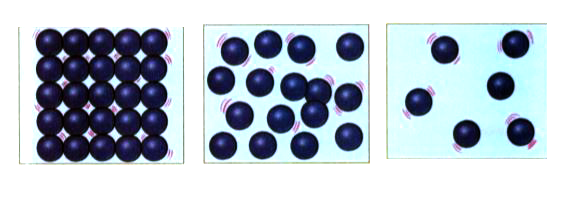Explain the nature of molecules in solids, liquids and gases.
Step by step video & image solution for Explain the nature of molecules in solids, liquids and gases. by Chemistry experts to help you in doubts & scoring excellent marks in Class 8 exams.
Updated on:21/07/2023Topper's Solved these Questions
- MATTERBOOK - ICSECHAPTER - MATTEREXERCISE - Exercise (Complete these word equations)
3 Videos
- MATTERBOOK - ICSECHAPTER - MATTEREXERCISE - Think and answer
7 Videos
- MATTERBOOK - ICSECHAPTER - MATTEREXERCISE - Exercise (Answer the following in short)
6 Videos
- LANGUAGE OF CHEMISTRY BOOK - ICSECHAPTER - LANGUAGE OF CHEMISTRY EXERCISE - Exercise (Balance the following equations)
4 Videos
- PHYSICAL & CHEMICAL CHANGESBOOK - ICSECHAPTER - PHYSICAL & CHEMICAL CHANGESEXERCISE - OBJECTIVE TYPE QUESTIONS (Physical & Chemical Changes)
21 Videos
Similar Questions
The theory that enables us to understand the behaviour of molecules of solids, liquids and gases
View SolutionCompare densities of solids, liquids, and gases.
View SolutionExplain the arrangement of particles in liquids and gases.
View SolutionList the characteristics of solids, liquids and gases
View SolutionSolid, liquid, light, gas
View Solution
a.Identify which of the above pictures shows particle arrangement in solids, liquids and gases. Write in the space below each picture.
b. Which state of matter would you expect to show a fixed volume?
c. Why do you think gases can flow whereas solids cannot?
View SolutionExplain the change of state from solid to liquid on the basis of kinetic theory.
View SolutionIn which of the three states of matter - solids, liquids or gases is the movement of atoms about their own position. Give a reason for the same.
View SolutionStatement-1 : Transverse mechanical waves can not be propagated in liquids and gases.
Statement-2 : Molecules in liquids and gases are having some finite separation from each other.
View SolutionAssertion : Bulk modulus of elasticity can be defined for all three states of matter, solid liquid and gas.
Reason: Young's modulus is not defined for liquids and gases.
View Solution
